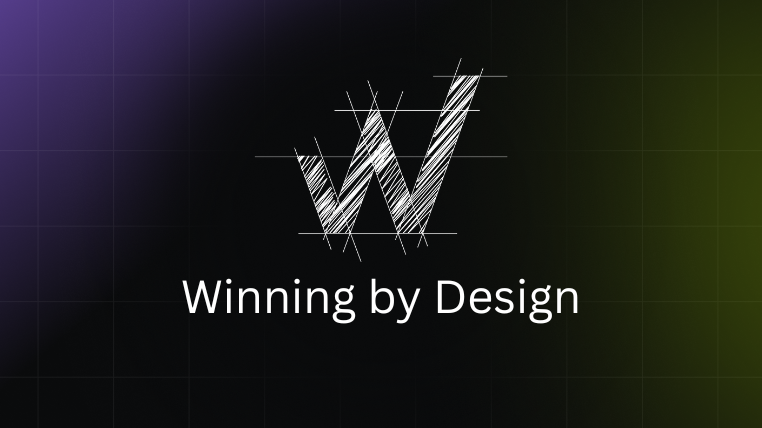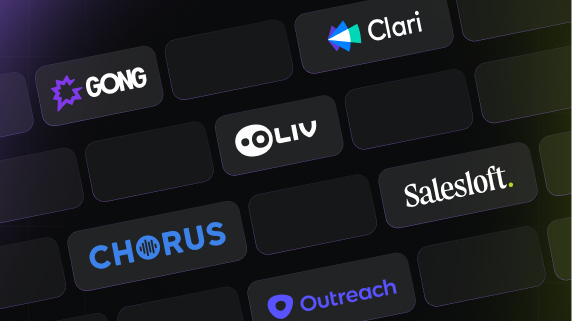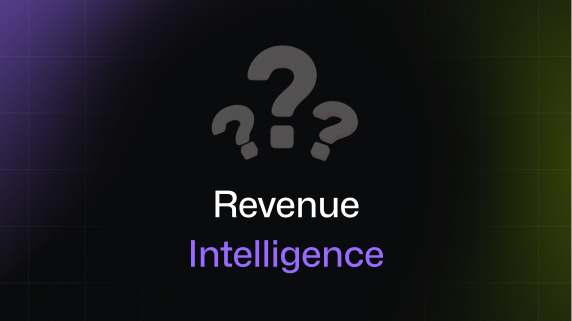Q1: What is Clari and Why Are Sales Teams Using It in 2025? [toc=Clari Overview]
Clari has established itself as a leading revenue intelligence platform, primarily built around its roll-up forecasting capabilities. The platform was designed to solve a fundamental problem that plagued sales organizations for decades: the manual, error-prone process of consolidating forecasts from individual reps up through management layers. Traditionally, this involved sales managers collecting spreadsheets from various representatives, combining them with their own judgment, and passing consolidated forecasts up the organizational chain—a time-intensive process fraught with inconsistencies and delays.
However, Clari's traditional SaaS approach reveals significant limitations inherent in pre-generative AI platforms. The system still relies heavily on manual data entry and activity-based signals that fail to capture the nuanced context of sales conversations. Users frequently report administrative burdens that slow deal velocity rather than accelerate it.
"The UI is not very intuitive and feels clunky. The search function is really frustrating... I have to maintain my own separate spreadsheet to track deals because I can only capture what my leaders want to see about a deal."
— Verified User in Human Resources, Enterprise G2 Verified Review
Modern AI has fundamentally transformed how revenue intelligence can operate. Instead of requiring manual roll-ups and activity tracking, generative AI platforms can automatically understand conversation context, email exchanges, and deal signals without human intervention. This shift enables autonomous forecasting that continuously updates based on real-time intelligence rather than periodic manual inputs, similar to how AI agents for sales teams are revolutionizing traditional sales processes.
Oliv.ai's Forecaster Agent exemplifies this AI-native evolution by generating weekly forecasts autonomously with AI commentary and comprehensive risk assessment. Unlike Clari's manual forecasting process, our Forecaster Agent provides a one-page report with presentation-ready views that detail what has happened and what requires immediate attention. The Pipeline Tracker and Deal Driver agents work in tandem to boost deal velocity through automated updates and proactive risk flagging, while the Analyst Agent handles complex queries and win-loss analysis—all without requiring manual setup or ongoing maintenance.
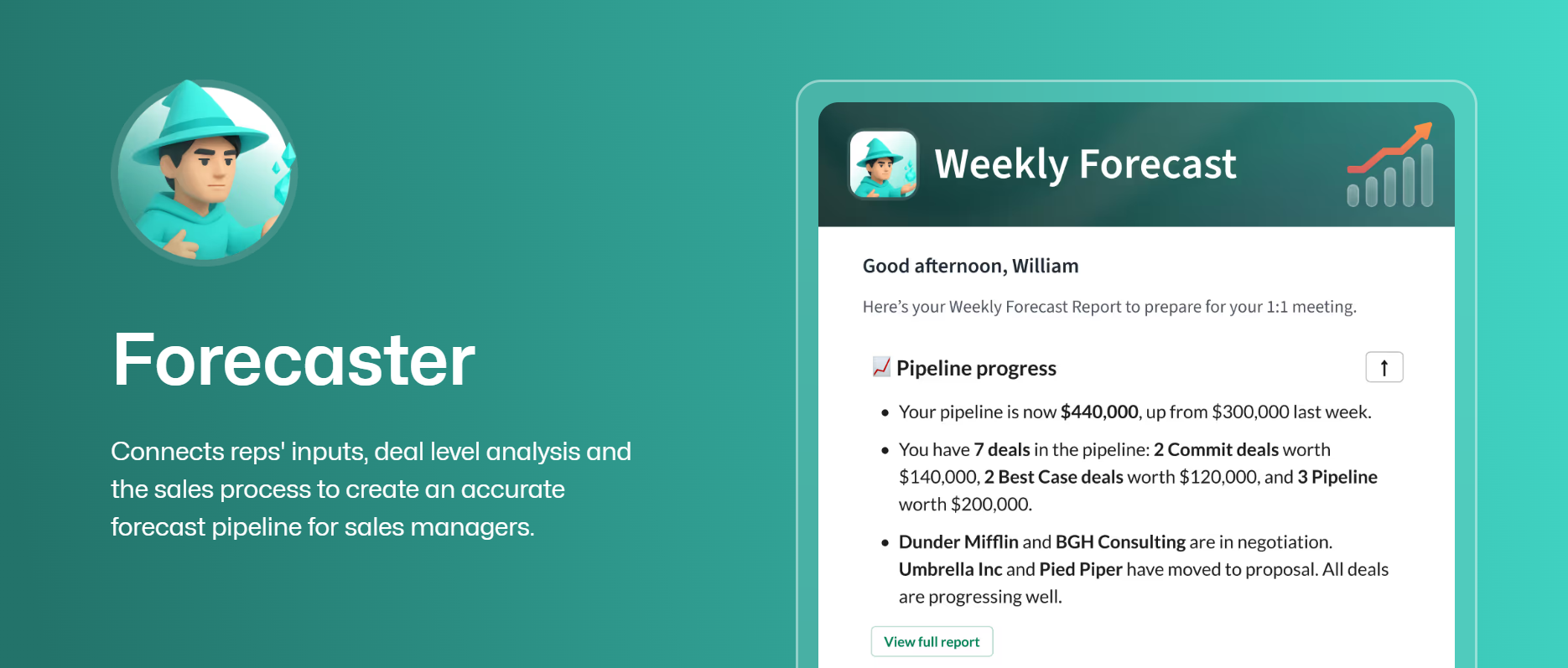
Industry benchmarks demonstrate the superiority of unified AI platforms, with teams reporting 25% higher forecast accuracy and 75% reduction in forecasting time compared to traditional manual systems. Companies consolidating from stacked legacy tools to AI-native platforms like Oliv.ai consistently achieve 30% faster deal cycles while eliminating the administrative overhead that characterizes older SaaS solutions.
Q2: How Much Does Clari Actually Cost in 2025? (Complete TCO Analysis) [toc=Pricing Analysis]
Understanding Clari's true cost requires examining both transparent pricing and hidden expenses that significantly impact total cost of ownership.
Base Pricing Structure
Clari's pricing generally starts at approximately $100 per user per month for core forecasting functionality. However, this base price represents only a fraction of actual implementation costs.
Premium Module Costs
- Clari Copilot (conversation intelligence): Additional $100/user/month
- Groove (sales engagement): Often bundled with Copilot
- Combined pricing typically reaches $200+ per user monthly
"Clari features often overlap with other common sales tech tools. Clari should do more to differentiate themselves from competition."
— Sarah J., Senior Manager Revenue Operations, Mid-Market G2 Verified Review
Hidden Implementation Expenses
Additional platform fees include:
- Implementation services: $15,000-$50,000 depending on complexity
- Professional services for setup: $25,000-$75,000 for enterprise
- Training and onboarding: $10,000-$25,000
- Integration consulting: $5,000-$20,000 per CRM connection
- Ongoing maintenance and support: 20% of annual license fees
Total Cost of Ownership Reality
For a 50-user sales team, annual costs typically include:
- Base licenses: $120,000 ($200 × 50 × 12)
- Implementation: $40,000 average
- Professional services: $35,000 average
- Training: $15,000 average
- Total Year 1: ~$210,000 ($4,200 per user annually)
The "Double Tool" Problem
Many organizations stack Clari with conversation intelligence platforms like Gong, creating combined costs of $400-500 per user monthly ($4,800-$6,000 annually per user). This expensive tool stacking approach is precisely what modern sales automation tools are designed to eliminate through unified platforms.
"Clari is a tool for sales leaders, it adds no value to reps as far as I can see."
— Msoave, r/SalesOperations Reddit
Oliv.ai's Transparent Alternative
Oliv.ai eliminates the double-tool problem with unified AI-native pricing starting at $19/user/month, including all conversation intelligence, forecasting, and pipeline management capabilities—representing up to 90% cost reduction compared to stacked traditional solutions while delivering superior AI-powered automation.
Q3: What Features Does Clari Offer and How Do They Compare to AI-Native Platforms? [toc=Feature Comparison]
Clari's feature architecture spans multiple modules designed to address different aspects of revenue operations. The platform includes Clari Core for forecasting, Copilot for conversation intelligence, Groove for sales engagement, and RevDB for data warehousing. These modules integrate with CRM systems, primarily Salesforce, to provide pipeline visibility and analytics capabilities. The system offers customizable dashboards, deal inspection tools, and reporting functionality that many sales leaders find valuable for high-level pipeline analysis.
However, Clari's traditional SaaS limitations become apparent in daily operations. The platform requires extensive manual configuration, separate training for each module, and ongoing data hygiene maintenance. Users consistently report clunky interfaces and complex workflows that slow productivity rather than enhance it. The conversation intelligence relies on keyword-based tracking rather than contextual understanding, missing nuanced deal risks that human analysis would catch. This represents a stark contrast to modern approaches that leverage MEDDIC sales methodology insights automatically through AI analysis.
"Groove is just a basic interface that connects to salesforce and a dialer, Aircall. The workflow is clunky and confusing. The platform is missing a ton of features and functionality that I've had with other tools like Outreach.io, Salesloft, Hubspot, etc."
— Austin N., SDR, Mid-Market G2 Verified Review
Modern AI evolution has enabled unified platforms that eliminate the need for separate modules and manual configuration. Generative AI can automatically understand conversation context, email sentiment, and deal progression without requiring keyword setup or manual data entry. This technological advancement allows for seamless integration across all revenue touchpoints while providing deeper insights through natural language processing rather than activity-based tracking. Unlike traditional platforms, modern AI systems can automatically extract insights similar to how Gong vs Clari comparisons show the evolution toward more intelligent systems.
Oliv.ai's unified approach through specialized AI agents addresses every aspect of revenue operations through autonomous intelligence. Our Meeting Assistant automatically joins, transcribes, and analyzes all sales calls without manual setup. The Deal Driver agent proactively identifies risks and suggests next steps based on conversation analysis, while the Pipeline Tracker maintains real-time deal health scoring across the entire portfolio. The Analyst Agent provides comprehensive win-loss analysis and answers complex revenue questions instantly—all functioning as a cohesive system rather than separate tools requiring individual management, particularly beneficial for sales managers seeking streamlined operations.
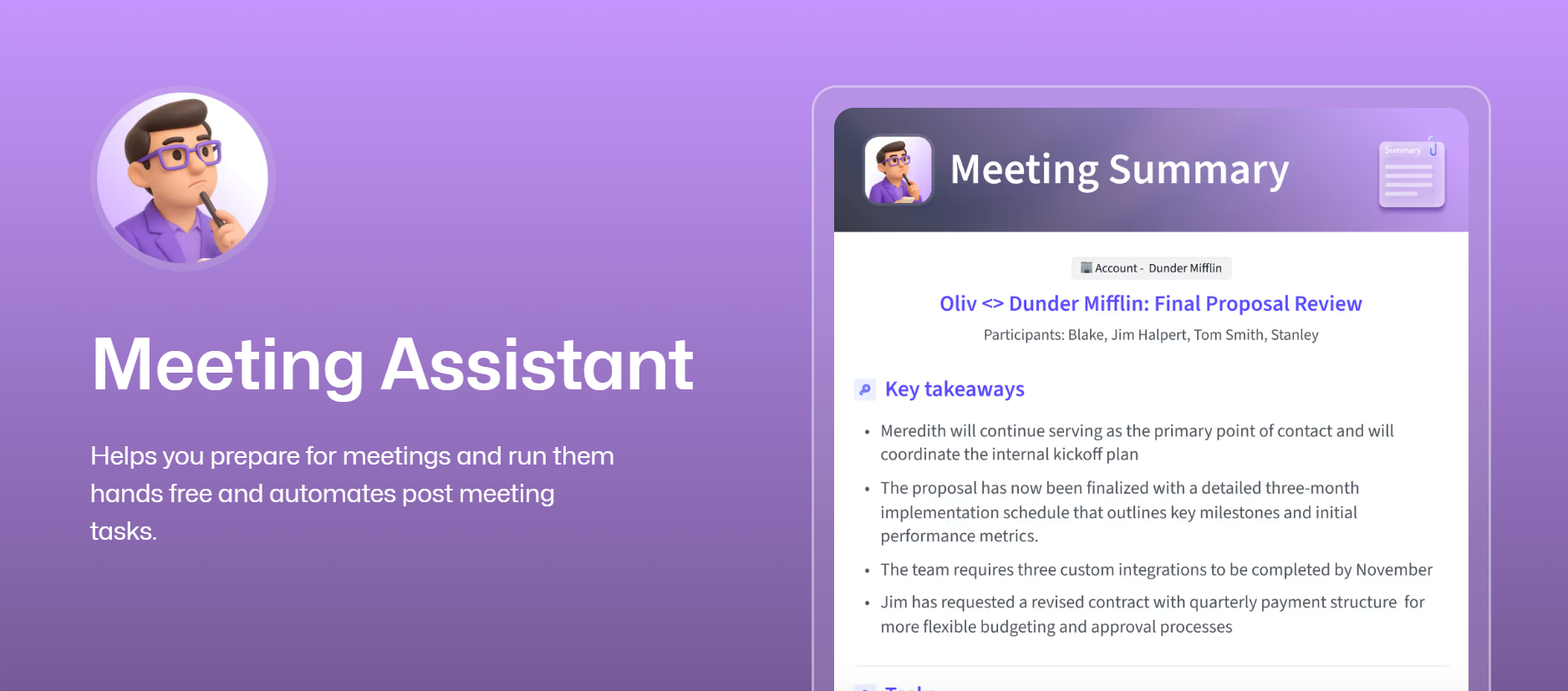
Comparative analysis reveals significant operational advantages: teams using Oliv.ai report 40% reduction in administrative overhead through agentic automation versus manual SaaS processes, while achieving more accurate insights through generative AI that truly understands conversation context rather than tracking keywords and activities.
Q4: What Do Real Users Say About Clari in 2025? (Reviews by Role and Company Size) [toc=User Reviews Analysis]
Understanding real user experiences across different organizational sizes and roles provides crucial insights for potential buyers evaluating Clari. Based on comprehensive analysis of verified user reviews from G2, TrustRadius, and community discussions, user satisfaction varies significantly depending on company size, role, and specific use cases.
Enterprise User Feedback (1000+ Employees)
Sales Representatives and Account Executives
Enterprise sales reps present mixed experiences with Clari's core functionality. Positive feedback centers around forecasting visibility and Salesforce integration, while significant concerns emerge around user interface design and administrative burden.
"What I find most helpful about Clari is being able to update close dates and forecasting. It's fairly intuitive to use and it integrates well with Salesforce. I use it every single week and often check it daily to make sure I'm aligned on the deals that I am running."
— Jezni W., Sales Account Executive, Enterprise G2 Verified Review
However, usability concerns dominate many enterprise user reviews:
"The UI is not very intuitive and feels clunky. The search function is really frustrating - I should be able to type in a company name and get all results versus clicking on a few options that limit results. Its not easy to find calls or conversations... I have to maintain my own separate spreadsheet to track deals because I can only capture what my leaders want to see about a deal."
— Verified User in Human Resources, Enterprise G2 Verified Review
Revenue Operations and Management
Enterprise RevOps professionals generally appreciate Clari's forecasting capabilities but express frustration with implementation complexity and ongoing maintenance requirements, particularly when compared to modern sales automation tools that offer streamlined operations.
"Real time updation. reliable Al prediction. Great analytical features like waterfall, Pulse, Funnel, Flow and Tren charts"
— Bharat K., Revenue Operations Manager, Enterprise G2 Verified Review
The same user noted significant limitations:
"Some users may find Clari's analytics and forecasting tools complex, requiring significant onboarding and training. While Clari integrates with many CRM platforms, users occasionally report difficulties syncing data seamlessly, especially with custom CRM setups."
— Bharat K., Revenue Operations Manager, Enterprise G2 Verified Review
Mid-Market User Experiences (51-1000 Employees)
Sales Development and Business Development
Mid-market SDRs and BDRs report particularly poor experiences with Clari's Groove module, citing workflow inefficiencies and missing functionality compared to alternatives like those discussed in Gong vs Salesloft comparisons.
"Groove is just a basic interface that connects to salesforce and a dialer, Aircall. The workflow is clunky and confusing. The platform is missing a ton of features and functionality that I've had with other tools like Outreach.io, Salesloft, Hubspot, etc."
— Austin N., SDR, Mid-Market G2 Verified Review
Multiple users echoed similar frustrations with Groove's limitations:
"Groove is terrible, I don't recommend it at all to any sales team. This solution isn't designed for salespeople, it's slow and annoying to use. It looks to be designed for marketers."
— Account Executive, IT Services Gartner Peer Insights
Sales Management and Operations
Mid-market sales managers present more balanced perspectives, acknowledging Clari's forecasting strengths while highlighting operational challenges that sales managers face with traditional platforms.
"I love how easy Clari makes forecasting. It is intuitive for sellers and managers to input their forecast. The out of the box analytics are also very helpful... Overall, it was also easy to set up but requires commitment to get full use out of the tool."
— Sarah J., Senior Manager Revenue Operations, Mid-Market G2 Verified Review
The same user identified competitive positioning concerns:
"Clari features often overlap with other common sales tech tools. Clari should do more to differentiate themselves from competition. The dashboarding and reporting can be limited based on what you are looking to do."
— Sarah J., Senior Manager Revenue Operations, Mid-Market G2 Verified Review
Role-Specific User Experiences
Customer Success Managers
Customer Success teams report positive experiences with Clari's CRM integration and AI features, particularly for portfolio management, though they note limitations compared to more advanced note-taking AI solutions.
"My favorite part of Clari is the two-way integration with our CRM... My other favorite feature is the CoPilot Ai. I think it's truly great at delivering call intelligence. The summary feature has quickly eliminated the need for taking separate call notes."
— Dexter L., Customer Success Executive, Mid-Market G2 Verified Review
Sales Enablement and Training Teams
Sales enablement managers appreciate automation capabilities but struggle with user interface complexity for template management.
"The user interface to find templates and flows is difficult and clunky. The massive list of templates can't be sorted and the search function isn't helpful... When building a new flow/folder, I see everyone's and can't filter or sort."
— Jennie T., Sales Enablement Manager, Mid-Market G2 Verified Review
Customer Support and Implementation Experiences
User feedback on Clari's customer support presents mixed results, with response quality varying significantly across implementations.
Positive Support Experiences
"Support requests are addressed quickly, and the integration with Salesforce refreshes the data consistently."
— Andrew P., Business Development Manager, Mid-Market G2 Verified Review
"CSM attention and support has been solid"
— Auseh B., Information Technology and Services, Mid-Market G2 Verified Review
Implementation and Training Challenges
"I would like easier access to training to enable me to better Forecast, pull data and access dashboards. As it stands I have had no training."
— Edwin M., Senior Director Legal, Mid-Market G2 Verified Review
"We recently had a support issue with replies not being recorded in Salesforce.com and getting it resolved was taking a very long time. The lack of visibility hindered our ability to manage the sales process effectively."
— Auseh B., Information Technology and Services, Mid-Market G2 Verified Review
Community Sentiment Analysis
Reddit discussions reveal broader industry sentiment about Clari's positioning and value proposition, often comparing it unfavorably to modern alternatives and highlighting challenges with sales team collaboration:
"Clari is a tool for sales leaders, it adds no value to reps as far as I can see."
— Msoave, r/SalesOperations Reddit
"It is really just a glorified SFDC overlay. Actually, Salesforce has built most of the forecasting functionality by now anyway so I'm not sure where they fit into that whole overcrowded Martech space."
— conaldinho11, r/SalesOperations Reddit
Summary of User Satisfaction Patterns
Positive Feedback Trends:
- Strong forecasting capabilities for management
- Effective Salesforce integration
- Useful AI summary features in Copilot
- Good analytics and reporting for pipeline visibility
Consistent Pain Points:
- Clunky, non-intuitive user interface
- Complex implementation requiring extensive training
- Groove module significantly underperforming versus alternatives
- Administrative overhead for daily users
- Limited customization without admin approval
Role-Based Satisfaction:
- Highest satisfaction: Senior sales leaders and RevOps managers
- Moderate satisfaction: Account executives and customer success
- Lowest satisfaction: SDRs, BDRs, and frontline sales reps
Company Size Impact:
- Enterprise users report more implementation complexity
- Mid-market teams struggle with feature limitations
- Smaller teams find tool overhead excessive for value delivered
Oliv.ai's Simplified Alternative: Modern AI-native platforms like Oliv.ai address these user experience challenges through autonomous agents that eliminate manual interface complexity while providing superior conversation intelligence and forecasting accuracy without requiring extensive training or ongoing maintenance overhead, particularly benefiting teams looking for comprehensive AI agents for sales teams solutions.
Q5: How Easy is Clari to Integrate and Implement? (Setup Reality Check) [toc=Integration Setup]
Clari's implementation process typically requires 8-16 weeks for complete deployment, involving multiple phases of CRM integration, user training, and workflow configuration. The platform's primary integration focus centers on Salesforce connectivity, with additional support for HubSpot and other major CRM systems. Implementation teams must navigate complex data mapping requirements, custom field configurations, and validation rule alignments between Clari and existing CRM instances. Professional services engagement is generally required for enterprise deployments, adding both timeline and cost considerations to the project scope.
However, traditional SaaS implementation approaches reveal significant operational burdens that extend well beyond initial setup. Users consistently report challenges with ongoing maintenance requirements, where changes in one system necessitate manual updates across multiple platforms. The complexity multiplies when organizations need to maintain validation rules in both Salesforce and Clari instances simultaneously, creating potential data inconsistencies and administrative overhead. These challenges are precisely why modern sales automation tools are designed to eliminate such integration complexity.
"Additionally, it's sometimes difficult (if you don't have a strong RevOps/RevTech team) to maintain validation rules in both Salesforce and Clari instances. That integration could be more seamless (although it's still quite good)."
— Dan J., Mid-Market G2 Verified Review
Modern AI-native platforms eliminate these integration complexities through intelligent automation and simplified deployment protocols. Instead of requiring extensive configuration mapping and manual data synchronization, generative AI can automatically understand existing CRM structures and adapt seamlessly without disrupting current workflows. This technological evolution enables rapid deployment timelines measured in weeks rather than months, similar to how Gong integrations have evolved to become more streamlined.
Oliv.ai's streamlined implementation approach delivers full functionality within 2 weeks through our automated CRM integration system. Our CRM Manager Agent automatically syncs with existing Salesforce or HubSpot configurations without requiring complex field mapping or validation rule duplication. The Meeting Assistant begins joining and transcribing calls immediately upon deployment, while the Pipeline Tracker and Deal Driver agents start providing insights based on existing deal data without manual training or configuration requirements.
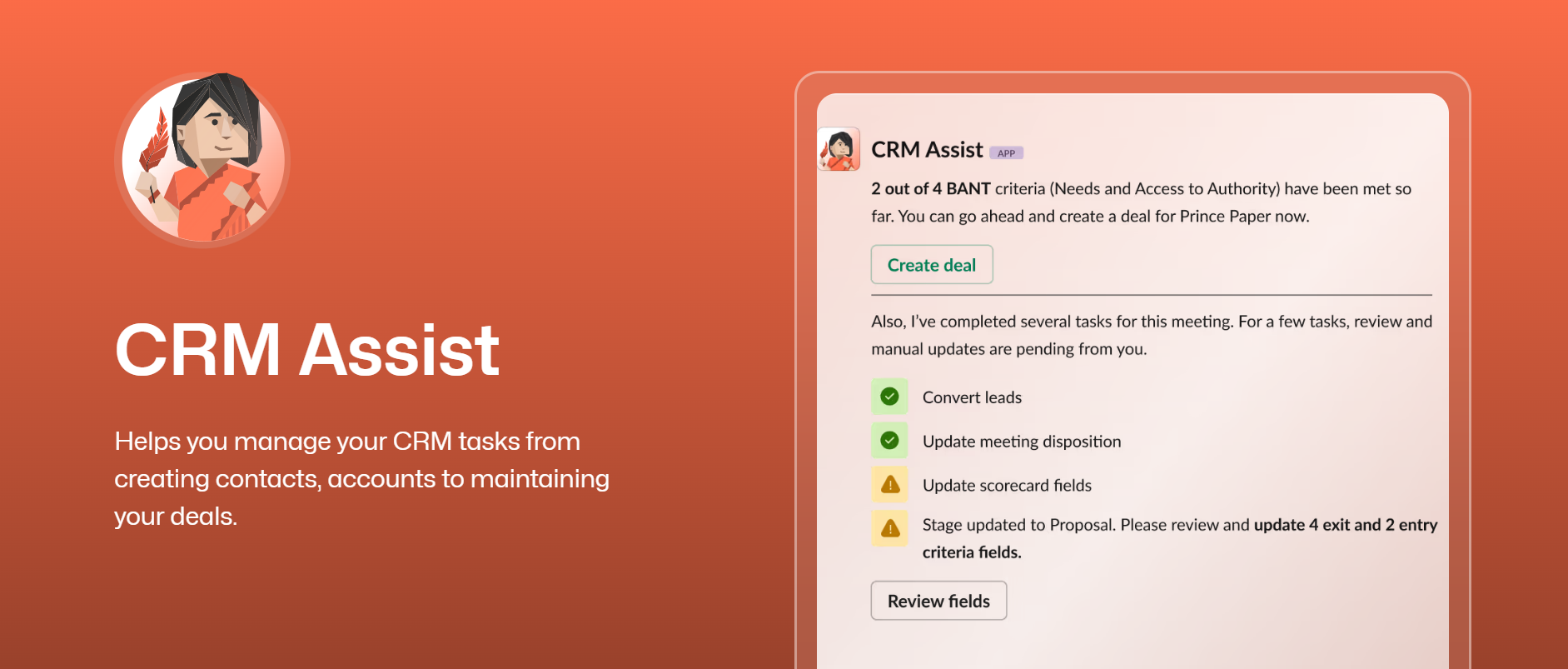
Comparative deployment analysis demonstrates significant efficiency gains: organizations implementing AI-native platforms report 75% faster deployment timelines compared to traditional enterprise software, with zero disruption to existing sales workflows and immediate value realization upon activation.
Q6: What's Clari's Customer Support and Training Like? [toc=Customer Support]
Support Response Quality and Availability
Clari's customer support presents mixed user experiences across different implementation phases and company sizes. Positive support interactions typically involve responsive account management and quick resolution of technical issues.
"Support requests are addressed quickly, and the integration with Salesforce refreshes the data consistently."
— Andrew P., Business Development Manager, Mid-Market G2 Verified Review
"CSM attention and support has been solid"
— Auseh B., Information Technology and Services, Mid-Market G2 Verified Review
Training Resources and Accessibility
Training accessibility represents a significant challenge for many Clari users. Multiple reviews highlight insufficient onboarding resources and limited access to comprehensive training materials, particularly when addressing common meeting challenges that sales teams face.
"I would like easier access to training to enable me to better Forecast, pull data and access dashboards. As it stands I have had no training."
— Edwin M., Senior Director Legal, Mid-Market G2 Verified Review
Complex onboarding requirements create barriers for effective platform adoption, particularly for users requiring advanced analytics and forecasting capabilities.
"Some users may find Clari's analytics and forecasting tools complex, requiring significant onboarding and training."
— Bharat K., Revenue Operations Manager, Enterprise G2 Verified Review
Support Issue Resolution Challenges
Critical support incidents reveal systemic resolution delays that impact sales operations effectiveness. Extended resolution times for core functionality issues create operational disruptions that could be avoided with more modern approaches to sales team collaboration.
"We recently had a support issue with replies not being recorded in Salesforce.com and getting it resolved was taking a very long time. The lack of visibility hindered our ability to manage the sales process effectively."
— Auseh B., Information Technology and Services, Mid-Market G2 Verified Review
Professional Services Requirements
Enterprise implementations typically require professional services engagement, adding both cost and complexity to deployment projects. Organizations without dedicated RevOps teams face particular challenges maintaining platform configurations and troubleshooting integration issues.
Documentation and Self-Service Options
User feedback indicates limited self-service documentation and help resources, particularly for advanced features and custom configurations. Sales teams often struggle to access comprehensive guides for independent problem resolution.
Oliv.ai's Simplified Support Approach: Our AI-native platform eliminates most traditional support needs through autonomous operation and intelligent self-maintenance. The system requires minimal training since AI agents handle complex tasks automatically, while our responsive support team provides immediate assistance for the rare instances when human intervention is needed.
Q7: How Does Clari Compare to Competitors and What Are the Best Alternatives? [toc=Competitor Comparison]
The current revenue intelligence landscape forces organizations into complex tool stacking arrangements to achieve comprehensive sales insights. Most companies deploy both conversation intelligence platforms like Gong ($250/user monthly) and forecasting tools like Clari ($200/user monthly) to cover their revenue operations needs. This fragmented approach creates combined costs of $400-500 per user monthly, while also requiring separate training programs, multiple vendor relationships, and disparate data sources that rarely integrate seamlessly. This expensive stacking approach is why many organizations seek Gong alternatives that provide unified functionality.
Traditional tool stacking reveals significant operational limitations that compound over time. Teams struggle with fragmented workflows where conversation insights from Gong don't automatically inform forecasting decisions in Clari, requiring manual data transfer and interpretation. Multiple vendor relationships create support complexity, with finger-pointing between providers when integration issues arise. Training overhead multiplies as each platform requires separate onboarding, ongoing education, and user adoption initiatives. This complexity is evident when comparing Gong vs Clari implementations.
"Clari features often overlap with other common sales tech tools. Clari should do more to differentiate themselves from competition."
— Sarah J., Senior Manager Revenue Operations, Mid-Market G2 Verified Review
The reddit community echoes these concerns about tool redundancy:
"It is really just a glorified SFDC overlay. Actually, Salesforce has built most of the forecasting functionality by now anyway so I'm not sure where they fit into that whole overcrowded Martech space."
— conaldinho11, r/SalesOperations Reddit
AI-native platforms eliminate the need for tool stacking by unifying conversation intelligence and forecasting within single generative AI systems. Modern platforms can simultaneously analyze call content, track deal progression, and generate autonomous forecasts without requiring separate tools or manual data reconciliation. This technological evolution enables seamless integration across all revenue touchpoints while providing deeper insights through unified data models rather than fragmented point solutions, similar to how Gong vs Outreach comparisons show the benefits of consolidated platforms.
Oliv.ai's comprehensive alternative consolidates the entire revenue intelligence stack through specialized AI agents that work autonomously across all sales activities. Our Meeting Assistant automatically captures and analyzes every customer interaction, while the Deal Driver agent identifies risks and suggests next steps based on comprehensive conversation analysis. The Forecaster Agent generates weekly forecasts with AI commentary, eliminating the manual forecasting processes that characterize traditional tools like Clari. The Pipeline Tracker maintains real-time deal health across the entire portfolio, while the Analyst Agent provides instant win-loss analysis and strategic insights—all functioning as a unified system with transparent pricing starting at $19/user monthly, providing capabilities that rival both Gong features and Clari's forecasting combined.
ROI analysis demonstrates substantial advantages for unified platforms: organizations switching from Gong+Clari combinations to AI-native solutions report 60% cost reduction and 30% faster deal cycles, while achieving 25% improved forecast accuracy through integrated intelligence rather than fragmented tool outputs.
Q8: What Are the Main Challenges and How to Overcome Them? [toc=Main Challenges]
Clari users consistently report operational challenges that stem from the platform's traditional SaaS architecture and complex interface design. Common frustrations include clunky user interfaces that require extensive navigation to complete basic tasks, complex implementation requiring 8-16 weeks for full deployment, and ongoing maintenance burdens that consume significant administrative resources. Multiple users cite the platform's non-intuitive design as a primary productivity barrier, with search functions that limit results and customization options that require administrator approval for basic modifications.
"The UI is not very intuitive and feels clunky. The search function is really frustrating - I should be able to type in a company name and get all results versus clicking on a few options that limit results... I have to maintain my own separate spreadsheet to track deals because I can only capture what my leaders want to see about a deal."
— Verified User in Human Resources, Enterprise G2 Verified Review
Traditional SaaS platforms create deeper structural limitations that extend beyond interface issues. Manual data hygiene requirements mean forecast accuracy depends entirely on CRM maintenance quality, creating ongoing administrative overhead for sales managers. The dependency on activity-based signals rather than contextual understanding leads to missed deal risks and coaching opportunities. Complex integration requirements with multiple touchpoints create potential failure points and require dedicated technical resources for ongoing maintenance, which is why many organizations are exploring sales automation tools that eliminate these manual processes.
"Additionally, it's sometimes difficult (if you don't have a strong RevOps/RevTech team) to maintain validation rules in both Salesforce and Clari instances. That integration could be more seamless."
— Dan J., Mid-Market G2 Verified Review
AI-native platforms address these fundamental challenges through autonomous operation and intelligent self-maintenance. Generative AI eliminates the need for complex manual configuration by automatically understanding existing data structures and adapting without disrupting workflows. Contextual conversation analysis replaces activity-based tracking, providing deeper insights without requiring keyword setup or manual rule maintenance. Simplified user experiences emerge naturally when AI agents handle complex tasks automatically rather than requiring human interface navigation, particularly beneficial for teams implementing command of the message methodologies.
Oliv.ai's approach eliminates traditional SaaS friction through our autonomous AI agent architecture. Implementation completes within 2 weeks through intelligent automation that requires zero configuration mapping. Our CRM Manager Agent maintains perfect data hygiene automatically, while the intuitive agentic interface eliminates training requirements since agents perform work autonomously rather than requiring manual user adoption. The Meeting Assistant, Deal Driver, and Pipeline Tracker agents operate continuously without maintenance overhead, providing proactive issue resolution and intelligent workflow optimization that addresses common meeting challenges sales teams face.
Implementation success metrics validate the AI-native advantage: teams deploying autonomous AI platforms report 75% faster onboarding compared to traditional enterprise software, with immediate value realization and zero disruption to existing sales processes, while achieving superior outcomes through intelligent automation rather than manual adoption requirements.
Q9: Is Clari Worth the Investment? (ROI Analysis by Team Size and Role) [toc=ROI Analysis]
Enterprise Teams (1000+ Employees)
For enterprise organizations, Clari demonstrates strongest value proposition among senior sales leadership and RevOps teams managing complex forecasting hierarchies. Enterprise users report positive ROI primarily through streamlined forecast consolidation and executive-level pipeline visibility.
"Super for forecasting and understanding full number to achieve inside quarter. Helps field, legal, SalesOps and DealOps collaborate to get better understanding of likely quarter outcome."
— Edwin M., Senior Director Legal, Enterprise G2 Verified Review
Enterprise ROI factors:
- Positive: Forecast accuracy improvements for leadership teams
- Positive: Multi-level hierarchy management capabilities
- Negative: High implementation costs ($40,000-75,000 professional services)
- Negative: Extended deployment timelines (12-16 weeks typical)
- Negative: Requires dedicated RevOps team for ongoing maintenance
Mid-Market Teams (51-1000 Employees)
Mid-market organizations present mixed ROI outcomes depending heavily on role and use case. Revenue operations managers generally achieve positive returns, while frontline sales roles struggle with user experience limitations, particularly when compared to modern AI agents for sales teams that provide better user experiences.
"I love how easy Clari makes forecasting. It is intuitive for sellers and managers to input their forecast... Overall, it was also easy to set up but requires commitment to get full use out of the tool."
— Sarah J., Senior Manager Revenue Operations, Mid-Market G2 Verified Review
However, mid-market users also highlight competitive positioning concerns:
"Clari features often overlap with other common sales tech tools. Clari should do more to differentiate themselves from competition."
— Sarah J., Senior Manager Revenue Operations, Mid-Market G2 Verified Review
Mid-market ROI considerations:
- Positive: Faster implementation than enterprise (6-12 weeks)
- Positive: Good Salesforce integration value
- Negative: Feature overlap with existing CRM capabilities
- Negative: Limited differentiation from native Salesforce functionality
Role-Specific Value Analysis
Sales Representatives and Account Executives
Lowest ROI group with consistent user experience challenges. Frontline reps report administrative burden exceeds productivity benefits.
"Clari is a tool for sales leaders, it adds no value to reps as far as I can see."
— Msoave, r/SalesOperations Reddit
Revenue Operations and Sales Management
Highest ROI group benefiting from centralized forecasting and pipeline analytics capabilities. Strong value for organizations with complex forecasting requirements, especially when implementing SPICED sales methodology frameworks.
Business Development Representatives
Negative ROI particularly with Groove module, which users consistently rate poorly compared to alternatives.
"Groove is terrible, I don't recommend it at all to any sales team. This solution isn't designed for salespeople, it's slow and annoying to use."
— Account Executive, IT Services Gartner Peer Insights
Cost-Benefit Analysis by Team Size
Small Teams (10-50 users): Poor ROI due to high per-user costs and implementation overhead relative to team size.
Medium Teams (50-200 users): Moderate ROI for management roles; negative for individual contributors.
Large Teams (200+ users): Best ROI scenario for senior leadership; mixed results for broader user base.
Oliv.ai's Superior Value Proposition: AI-native platforms eliminate role-based ROI disparities by providing autonomous intelligence that benefits all team members equally, with transparent pricing starting at $19/user monthly compared to Clari's $200+ per user costs, delivering immediate value without implementation complexity or ongoing maintenance overhead.
Q10: How Do Recent Acquisitions Impact Clari's Future Roadmap? [toc=Acquisition Impact]
Major Acquisition Activity and Platform Consolidation
Clari has pursued an aggressive acquisition strategy to expand beyond its core forecasting capabilities, acquiring Groove (sales engagement), Copilot (conversation intelligence), and other complementary technologies. This consolidation approach aims to create a comprehensive revenue operations platform rather than maintaining focused forecasting expertise.
Internal disruption from acquisition integration has created operational challenges that impact product development and customer experience. User feedback reveals integration inconsistencies and feature overlap issues stemming from rapid platform consolidation.
"Not much to dislike about Clari, but as it is still seemingly new there are some bumps in integration with salesforce. That might just be a user error, but I have seen a lot of improvement since I started using it."
— James S., Associate - Employee Benefits Consultant, Enterprise G2 Verified Review
Product Development Implications
The acquisition-driven roadmap prioritizes platform integration over user experience optimization. Multiple users report functionality limitations and interface challenges resulting from merged product architectures rather than native development, creating issues that modern Gong vs Oliv comparisons highlight as advantages of purpose-built AI platforms.
Reddit community discussions reveal internal instability affecting product direction and customer confidence:
"Not to mention the place is a nightmare internally with all the layoffs and acquisitions."
— conaldinho11, r/SalesOperations Reddit
"My best friend was a high performing account manager there and he got laid off while on paternity leave 4 or 5 months ago. Complete shit show."
— Idlinox, r/SalesOperations Reddit
Strategic Positioning Challenges
Acquisition strategy creates competitive vulnerability against native Salesforce capabilities and AI-first platforms. Users question long-term differentiation as CRM providers enhance built-in forecasting functionality, similar to concerns expressed in Gong reviews about legacy platform relevance.
"It is really just a glorified SFDC overlay. Actually, Salesforce has built most of the forecasting functionality by now anyway so I'm not sure where they fit into that whole overcrowded Martech space."
— conaldinho11, r/SalesOperations Reddit
Feature overlap concerns emerge as acquired capabilities duplicate existing market solutions without clear differentiation:
"Clari features often overlap with other common sales tech tools. Clari should do more to differentiate themselves from competition."
— Sarah J., Senior Manager Revenue Operations, Mid-Market G2 Verified Review
Future Roadmap Risks
Integration complexity increases as the platform attempts to unify disparate acquired technologies, potentially creating ongoing technical debt and user experience challenges that affect sales team collaboration.
Market positioning uncertainty emerges as traditional SaaS consolidation strategies face competition from AI-native platforms that provide unified functionality through generative intelligence rather than acquisition-based feature stacking.
Customer retention challenges may intensify as organizations evaluate whether consolidated legacy tools provide superior value compared to modern AI-first alternatives that eliminate integration complexity entirely.
Oliv.ai's Strategic Advantage: Rather than relying on acquisition-based consolidation, our AI-native architecture provides unified revenue intelligence through purpose-built generative AI agents, eliminating integration complexity while delivering superior functionality compared to traditional SaaS platforms attempting to merge disparate acquired technologies.
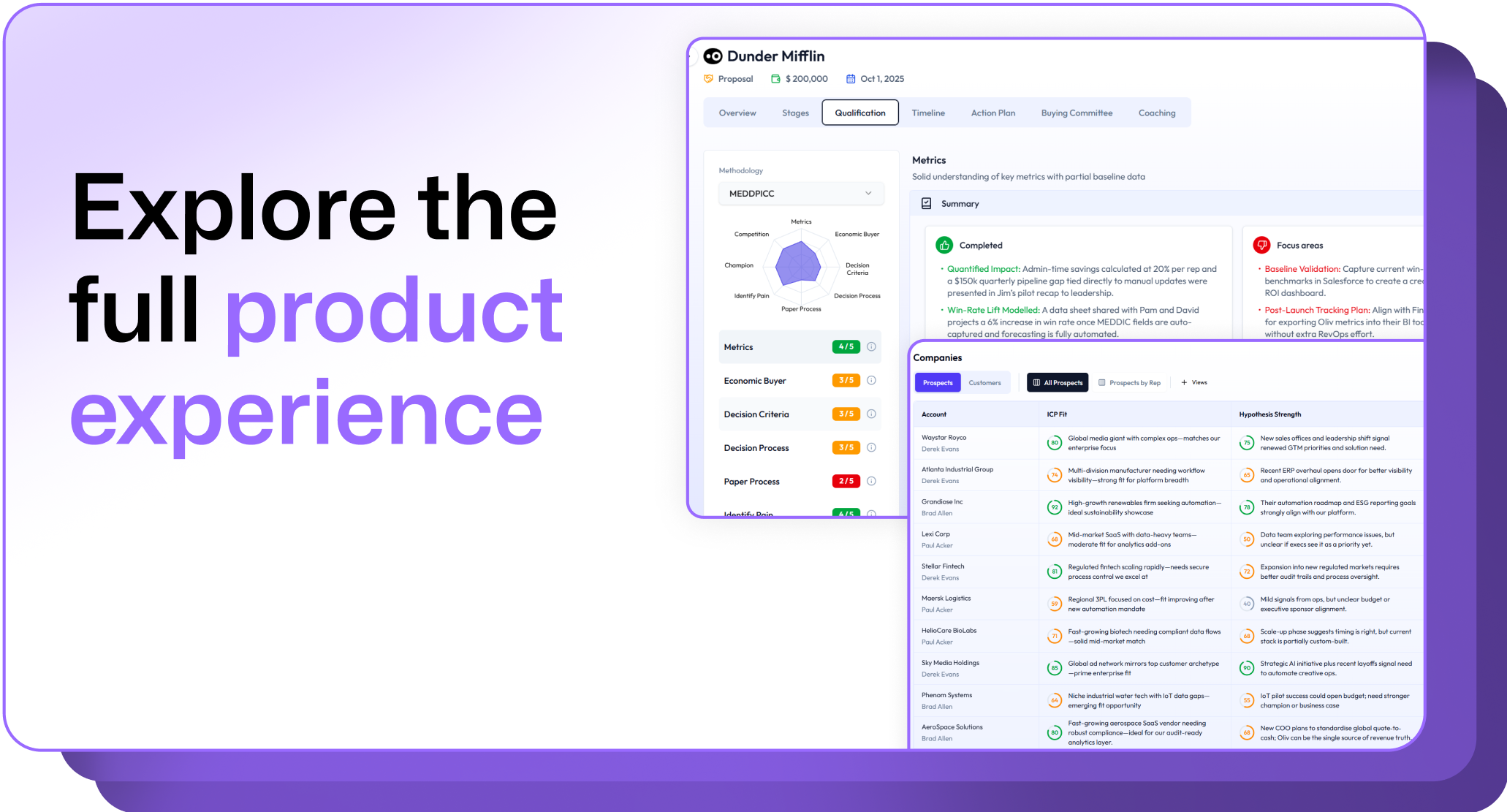
.png)
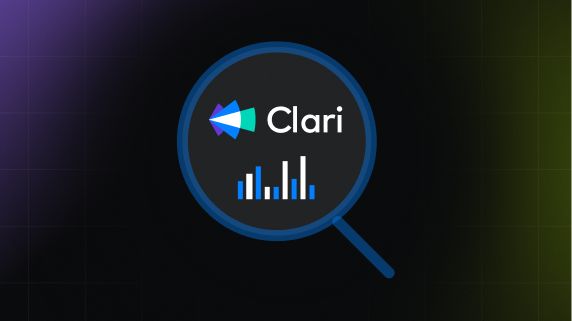


.png)
